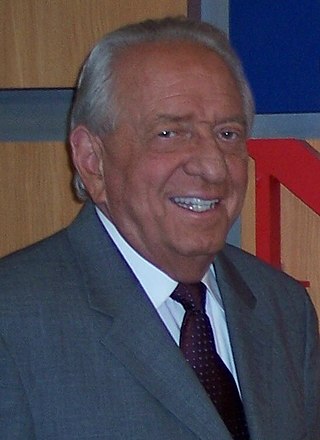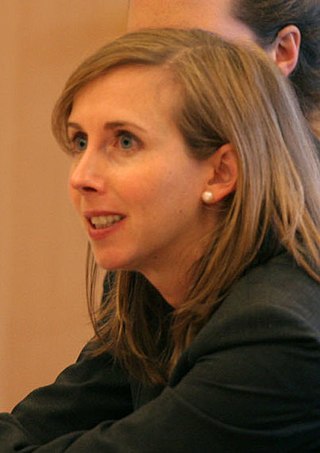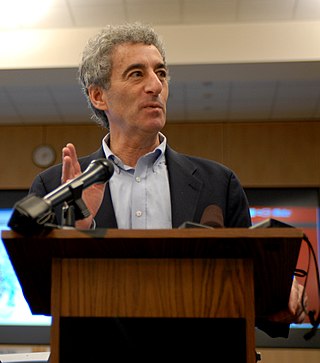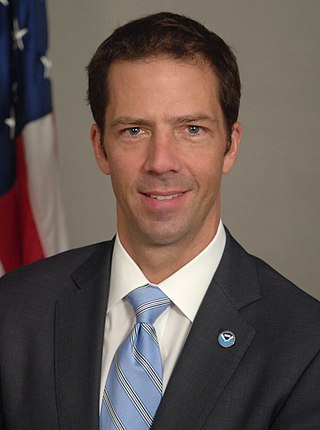
The National Oceanic and Atmospheric Administration is a US scientific and regulatory agency charged with forecasting weather, monitoring oceanic and atmospheric conditions, charting the seas, conducting deep-sea exploration, and managing fishing and protection of marine mammals and endangered species in the US exclusive economic zone. The agency is part of the United States Department of Commerce and is headquartered in Silver Spring, Maryland.

AccuWeather Inc. is a private-sector American media company that provides commercial weather forecasting services worldwide.

The American Meteorological Society (AMS) is a scientific and professional organization in the United States promoting and disseminating information about the atmospheric, oceanic, and hydrologic sciences. Its mission is to advance the atmospheric and related sciences, technologies, applications, and services for the benefit of society.

Roger A. Pielke Sr. is an American meteorologist with interests in climate variability and climate change, environmental vulnerability, numerical modeling, atmospheric dynamics, land/ocean – atmosphere interactions, and large eddy/turbulent boundary layer modeling. He particularly focuses on mesoscale weather and climate processes but also investigates on the global, regional, and microscale. Pielke is an ISI Highly Cited Researcher.

Washington, D.C. is located in the Mid-Atlantic region of the United States at 38°53′42″N77°02′11″W, the coordinates of the Zero Milestone, on The Ellipse. According to the United States Census Bureau, the city has a geographical area of 68.3 square miles (176.9 km2), 61.4 square miles (159.0 km2) of which is land, and the remaining 6.9 square miles (17.9 km2) (10.16%) of which is water. The Anacostia River and the smaller Rock Creek flow into the Potomac River in Washington.

Joe Witte recently retired as an Outreach Specialist for Aquent, a contractor of Jet Propulsion Laboratory, NASA. He adapted science content for use by 2,000 television meteorologists around the country.
Dalecarlia Reservoir is the primary storage basin for drinking water in Washington, D.C., and Arlington County, Virginia. The reservoir is fed by an underground aqueduct in turn fed by low dams which divert portions of the Potomac River near Great Falls and Little Falls. The reservoir is located between Spring Valley and the Palisades, two neighborhoods in Northwest Washington, D.C., and Brookmont, a neighborhood in Montgomery County, Maryland.
Joe Bastardi is a professional meteorologist and weather forecaster. He is a frequent guest on TV news shows. Bastardi is an outspoken denier of human-induced global warming whose public statements frequently contradict the scientific consensus on climate change.
The Climate Change Science Program (CCSP) was the program responsible for coordinating and integrating research on global warming by U.S. government agencies from February 2002 to June 2009. Toward the end of that period, CCSP issued 21 separate climate assessment reports that addressed climate observations, changes in the atmosphere, expected climate change, impacts and adaptation, and risk management issues. Shortly after President Obama took office, the program's name was changed to U.S. Global Change Research Program (USGCRP) which was also the program's name before 2002. Nevertheless, the Obama Administration generally embraced the CCSP products as sound science providing a basis for climate policy. Because those reports were mostly issued after the Fourth Assessment Report of the Intergovernmental Panel on Climate Change (IPCC), and in some cases focused specifically on the United States, they were generally viewed within the United States as having an importance and scientific credibility comparable to the IPCC assessments for the first few years of the Obama Administration.

John Stewart Coleman was an American television weatherman. Along with Frank Batten, he co-founded The Weather Channel and briefly served as its chief executive officer and president. He retired from broadcasting in 2014 after nearly 61 years, having worked the last 20 years at KUSI-TV in San Diego.

Heidi Cullen is the Director of Communications and Strategic Initiatives at the Monterey Bay Aquarium Research Institute (MBARI). Her efforts there are focused on inspiring the next generation of ocean explorers, communicating about the ocean’s critical role in our climate system, and advancing the use of autonomous technology to protect ocean health. Cullen was previously the Chief Scientist for the non-profit science communication organization Climate Central, where she was part of the team that incubated and launched the World Weather Attribution initiative. She taught a course in science communication at nearby Princeton University and is the author of The Weather of the Future. A climate scientist and science communicator, she served as The Weather Channel's climate expert from 2003 to 2008 and co-hosted Forecast Earth, the first hour-long television show dedicated to communicating climate change science, impacts, and solutions.

Willard Anthony Watts is an American blogger who runs Watts Up With That?, a climate change denial blog that opposes the scientific consensus on climate change. A former television meteorologist and current radio meteorologist, he is also founder of the Surface Stations project, a volunteer initiative to document the condition of U.S. weather stations. The Heartland Institute helped fund some of Watts' projects, including publishing a report on the Surface Stations project, and invited him to be a paid speaker at its International Conference on Climate Change from 2008 to 2014.

The January 1961 nor'easter was a significant winter storm that impacted the Mid-Atlantic and New England regions of the United States. It was the second of three major snowstorms during the 1960–1961 winter. The storm ranked as Category 3, or "major", on the Northeast Snowfall Impact Scale.

Peter John Webster is a meteorologist and climate dynamicist relating to the dynamics of large-scale coupled ocean-atmosphere systems of the tropics, notably the Asian monsoon. Webster holds degrees in applied physics, mathematics and meteorology. Webster studies the basic dynamics of the coupled ocean-atmosphere system in the tropics and has applied this basic knowledge to developing warning systems for extreme weather events in Asia. He has served on a number of prestigious national and international committees including the World Climate Research Program's Joint Scientific Committee (1983-1987), chaired the international Tropical Ocean Global Atmospheric (TOGA) organizing committee (1988–94) and was co-organizer of the multinational TOGA Couple Ocean-Atmosphere (1993). He is Emeritus Professor in Earth and Atmospheric Sciences at Georgia Institute of Technology and co-founder and Chief Scientist of Climate Forecast Applications Network LLC, a weather and climate services company.

Clifford F. Mass is an American professor of Atmospheric Sciences at the University of Washington. His research focuses on numerical weather modeling and prediction, the role of topography in the evolution of weather systems, regional climate modeling, and the weather of the Pacific Northwest. He is a fellow of the American Meteorological Society, past-president of the Puget Sound American Meteorological Society chapter, and past chair of the College of the Environment College Council.

Warming stripes are data visualization graphics that use a series of coloured stripes chronologically ordered to visually portray long-term temperature trends. Warming stripes reflect a "minimalist" style, conceived to use colour alone to avoid technical distractions to intuitively convey global warming trends to non-scientists.

A climate spiral is an animated data visualization graphic designed as a "simple and effective demonstration of the progression of global warming", especially for general audiences.

Edward Hawkins is a British climate scientist who is Professor of climate science at the University of Reading, principal research scientist at the National Centre for Atmospheric Science (NCAS), editor of Climate Lab Book blog and lead scientist for the Weather Rescue citizen science project. He is known for his data visualizations of climate change for the general public such as warming stripes and climate spirals.

Neil Andrew Jacobs, Jr. is an American scientist and former government official who served as the acting Under Secretary of Commerce for Oceans and Atmosphere and Administrator of the National Oceanic and Atmospheric Administration.